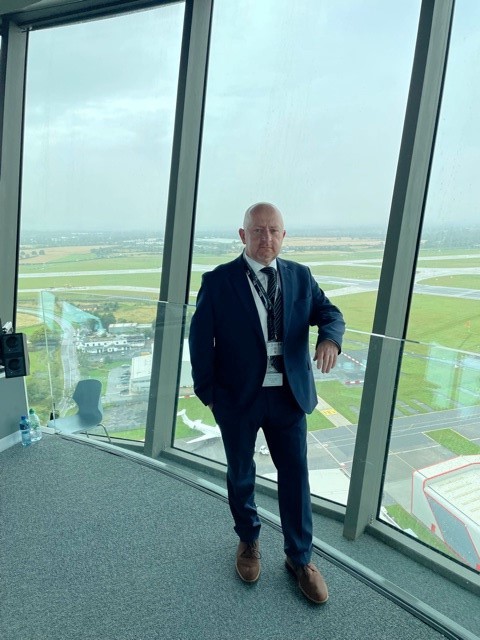CANSO Global Safety Conference 2023 – meet Captain Martin Timmons

Ahead of the CANSO Global Safety Conference, we had a conversation with Captain Martin Timmons, Head Of Safety Management Unit, AirNav Ireland. Captain Timmons will be one of the keynote speakers on the first day of the Conference and will address the topic of Leadership in a Safety Organisation with a session titled “In praise of the incomplete Safety Manager”. The CANSO Global Safety Conference will take place in Dublin, Ireland on November 27-30. Find out more here.

- How do you define leadership within a Safety Organisation, considering its unique challenges and responsibilities?
Trying to make sense of the vast amount of research and theories on leadership is challenging. Throughout the 100 years of research, there have been paradigm shifts and theories continually evolving, leaving the reader with a quandary of what theory best describes the leadership traits of successful leaders. Research indicates there is no template or formula for creating a leader; indeed, there are countless theories and definitions. Bennis (2009) notes that leadership is the most studied and least understood topic of any social sciences, probably not the best insight for ab initio leadership scholars.
Prentice (2004) defined leadership as “the accomplishment of a goal through the direction of human assistants”. The definition is an important concept as it implies a unified interface between a conceptualised leader and willingly followers. Bryman (1992) argues that leadership is a purpose-driven action that brings change or transformation. Bass (1985) argues that successful leadership requires successful management.
My definition of leadership is the ability of one individual to influence an individual or group to reach a goal using a combination or single leadership style and conscious of the environment and culture in which the change is being implemented.
- At the CANSO Global Safety Conference, you will be speaking at a session titled “In praise of the incomplete Safety Manager.” Could you elaborate on this concept and its significance in the context of safety leadership?
In my research I have tried to identify a style or template for a perfect leader, but it was a 2007 Harvard Business Review article by Deborah Ancona, Thomas W Malone, Wanda J. Orlikowski and Peter M Senge that helped me realise there is no such thing as a perfect leader. The article highlighted the four capabilities that a leaders should possess:
- Sense making – understanding the context in which a company and its people operate
- Relating – building relationships within and across organisations
- Visioning – creating a compelling picture of the future
- Inventing – developing new ways to achieve the vision
In my career to date as Safety Manager for Ryanair and now for AirNav Ireland I have endeavoured to deploy these capabilities in a structured format, knowing my strengths and in particular my weaknesses, delegating or knowing when to let go.
- Managing a Safety Organisation involves public safety and a high level of trust. How do you address the responsibility of maintaining public trust in safety initiatives?
One of the core characteristics of an effective leader is creating a vision that employees and customers accept and buy into this vision. A vision is an image of the future if innovation is deployed. Safety Managers must create a vision highlighting reasons for and the activities required to deploy innovation. The vision must be logically compelling and experientially appealing.
I strongly believe in a Quality Management System that listens to the Voice of the Customer (VoC), by listening to the VoC we better understand and meet our customers and staff needs and expectations, improving the safety of the service.
- What are some of the major challenges you’ve faced in your role as Head of Safety Management Unit, and how have you navigated them?
The regulations governing change management have been challenging. In my previous Air Operations experience we had well established regulations and change management was part of the ecosystem. However, under Regulations (EU) 2017/373 the rules and processes are far more prescriptive. Planning for the requirements and the additional workload and bring people of a journey of transformation and innovation have been challenging.
- For individuals aspiring to leadership roles in Safety Organisations, what advice would you offer?
Leadership is a complex topic. Even deciding on a definition is a challenge. However, most scholars agree that it is made up of two distinct traits the ability to influence others and how the leader’s characteristics and behaviours explain the influencing process.
Leadership development programs, self-help guides and coaching are a multimillion-dollar industry. Beer et al. (2016) indicates that American companies spend enormous amounts of money on employee training and education—US$160 billion in the United States and close to US$356 billion globally in 2015 alone. There is no doubt leadership training can make a huge difference in preparing individuals to advance in their careers and succeed in leadership role.
If you first understand that no one person could possibly stay on top of everything in an organisation. The myth of the complete leader (and the fear of appearing incompetent) makes many executives try to do just that, exhausting themselves and damaging their organizations in the process.
The incomplete leader knows when to let go, knows what leadership exists throughout the organisation and achieves this through a high degree of emotional intelligence (Daniel Goleman (2004) identifies emotional intelligence as a critical attribute of an effective leader. In the Harvard Business Review, Goleman’s article identifies five components of emotional intelligence: self-awareness, self-regulation, empathy, motivation, and social skills) and transformational attributes (transformational leaders openly recognise and reward individuals for their contributions and go above and beyond the norm expected).